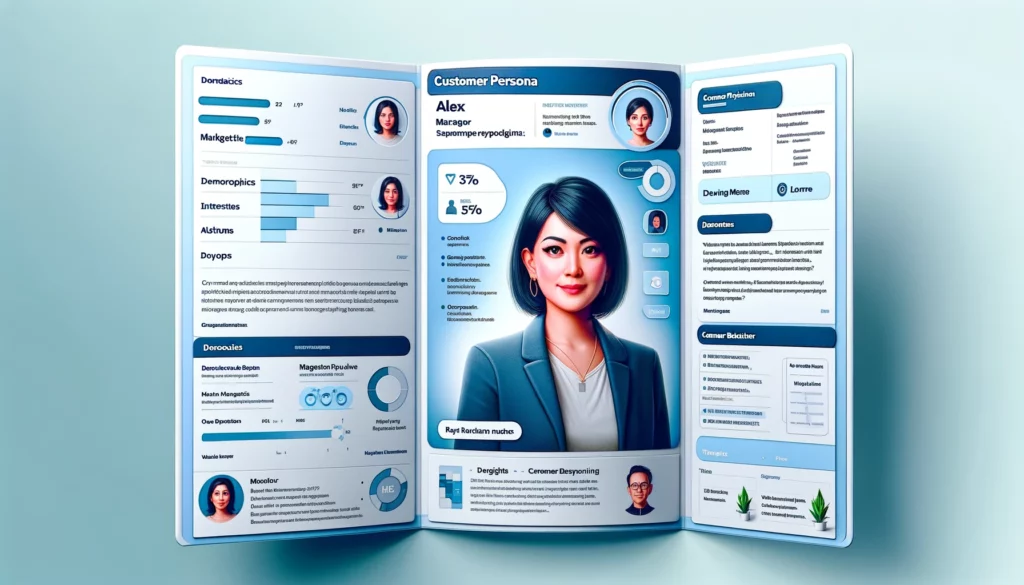Customer Personas: Understanding Your Audience for Targeted Marketing

If you haven’t used customer personas in our era of hyper-targeted marketing and advertising, there’s no better time than now. Though there’s some debate about the best approach to developing and using a customer persona (or avatar, as they’re sometimes called), these archetypal profiles can be game-changers when you employ them in a way that works for you.
We’ll share more about the purpose of the customer persona, and we’ll follow up with an action plan to help you build, refine, and use your buyer personas to improve your outreach and marketing.
What Is a Customer Persona?
A customer persona is an archetype that represents one type of customer your product or solution serves. It’s often a detailed document, sometimes professionally designed, that includes a photo of the fictional persona to help you visualize them as a real person. Some customer persona documents include pages of information, while others may be a simple table or bullet point list.
You may use multiple customer personas to model unique segments of your target market — or you may cater all of your marketing to just one persona. Business owners and marketers use customer personas to inspire and guide every step of the customer experience. These documents can help you stay unified in your marketing messaging, and they can even help you brainstorm new ideas for products or services that match that target persona’s pain points.
Customer personas usually distill market data down into a few key points that represent a “type” of person. This often includes:
- Basic demographics (e.g., age, gender, education level)
- Pain points that relate to your product or solution — what’s going on in the person’s life that made them search for a solution like yours?
- Preferred communication channels
- Favorite books, magazines, TV shows
As you can see, a buyer persona includes detailed information that helps you get a feel for your customer’s life and personality. Why do they work? It’s similar to how anecdotes or stories can help us retain information far better than plain information on its own. A customer persona is essentially a story about your customer that helps you visualize them in detail. It’s much easier to write marketing copy “to” a specific person rather than broadly to a faceless audience.
How do you create customer personas that actually benefit the business? Here’s our suggested approach.
Determine Your Goals and Make a Template
Before you start creating your first customer persona document, outline the business objectives you’re hoping to reach. Do you want to get more clarity for your written messaging? Do you want to increase conversions? Are you hoping to refine or change your product to better meet your customers’ needs?
Once you’ve identified your main goals, create a template for a customer persona that includes the most relevant information to your objectives. A B2B customer persona will look different than a B2C customer persona, as well. Though not a comprehensive list, here are some of the most common items to include in your buyer avatar:
B2C Customer Persona:
- Demographics: name, age, geographic location, marital status, gender identity, children, income
- Education level
- Work: job title or industry
- Favorites — hobbies, animals, ways to spend free time, TV shows, movies, books
- What they want and don’t want
- Objections or obstacles to purchasing a solution like yours
- How they search for a solution like yours
- How they feel before, during, and after purchasing
- Life motto or favorite quote
B2B Customer Persona
All of the above, plus:
- Details about job role: who do they report to? Who reports to them?
- Decision-making power: are they the sole decision-maker, or do they share this responsibility with someone else in the organization?
- Career goals and challenges
Gather Data
While you can build a customer persona based on guesswork and experience alone, it’s much better to be scientific. Your assumptions about your customers can seriously inhibit your ability to communicate and ultimately sell to them, so let go of your preconceived notions and start gathering data.
If you’re gathering data without the help of a market research professional, start by analyzing what you already have. Most marketing software has built-in analytics that will give you an idea of
Alternative options for gathering data include:
- Conducting a survey using a tool like SurveyMonkey
- Launching a focus group
- Interviews with key customers (these can double as potential case studies or testimonials)
- Conduct secondary online research
What data should you collect? This will vary depending on your business and your solutions, but a mix of basic demographic data, along with behavioral insights, customer preferences, and pain points, is a good place to start. And keep in mind: more detail isn’t always better. In some cases, simplicity paints a clearer picture of your buyer than pages of data points.
Create Your Persona
Gather your source materials and create the copy and design for your persona document. If you’re not a copywriter or graphic designer, consider working with a freelancer for a more polished end result. Determine if you want your document to be a digital resource, printed resource, or both.
Get creative with your persona. Write statements from the customer’s perspective. For example, instead of writing out a customer objection, put it in quotes: “I’m afraid to spend that much money on hiking shoes for my kids since they outgrow shoes so fast.”
Use Your Persona
Put your customer persona into action. Include it in creative briefs for your marketing agencies, freelancers, and team members. Make it easy to find and use for anyone involved in the sales process at your organization.
Refine and Update Over Time
This one is an important but often neglected step. As trends and consumer behaviors evolve, personas can become outdated very quickly. Designate someone to be the persona “updater.” Having one person responsible for keeping personas up-to-date on a regular schedule helps to ensure it actually gets done.
Audience Personas and Contact Management
Since our specialty is contact management, naturally, we want to connect the dots between audience personas and how they impact your contact management capabilities.
- Segmentation and Organization: Personas help in segmenting contacts into meaningful groups. This segmentation aids in organizing contact databases more efficiently, allowing professionals to easily identify and target groups for specific campaigns or communications.
- Prioritization of Contacts: Not all contacts are equally valuable for every purpose. Personas enable professionals to prioritize their contacts based on their relevance to specific goals or initiatives, ensuring that efforts are focused on the most promising leads or stakeholders.
- Content Strategy Development: Understanding audience personas assists in developing a content strategy that resonates with different segments of the audience. This can lead to more effective marketing campaigns and customer engagement.
- Crisis Management: In case of a crisis or negative feedback, understanding the personas can help in crafting tailored responses and strategies to mitigate the impact effectively.
- Networking and Relationship Building: Personas help in understanding the interests and motivations of different audience segments, which is crucial for effective networking and building long-term relationships.
- Cross-Selling and Up-Selling Opportunities: By understanding the needs and preferences of different personas, professionals can identify opportunities for cross-selling and up-selling more effectively.





